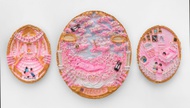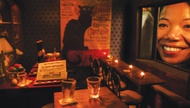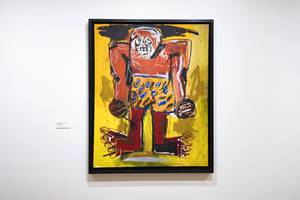
Transmutations: Robert Beckmann Under the Western Sky 1977-2017 Through March 18; Monday-Thursday, 10 a.m.- 8 p.m.; Friday-Sunday, 10 a.m.-6 p.m. The Studio at Sahara West Library, 702-507-3630.
Transmutations: Robert Beckmann Under the Western Sky 1977-2017 presents 59 canvases painted over four decades in one impressive exhibition. The message is clear: Beckmann is one heck of a painter. Large paintings, small paintings, realism, symbolism, expressionism, abstracts—the range alone is worth a visit, if not applause. Even viewers acquainted with Beckmann’s achievements will find a surprise, since the exhibition draws on artworks usually squirreled away in private collections, along with recent paintings (still drying) from last month.
Among the rarely exhibited works is “The Morning After, The Body of a House, #9,” completed in 1994. The enormous, 6-foot-by-8-foot painting depicts the boney remains of a 1952 Nevada Test Site house, meticulously constructed by Las Vegas home builders just so it could be blown to bits. Working from photographs taken at ground zero, Beckmann renders the desiccated planks, rafters, struts and beams with an anatomist’s accuracy, bathing them in golden light. The house becomes a martyred relic complete with halo, perhaps, or a seductive artifact glowing eerily with lethal radiation. Either way, the scale, palette and treatment of the subject result in a major work that stops viewers in their tracks.
Nevada Test Site activities are one of Beckmann’s favorite subjects; another is the Las Vegas Strip. In an intriguing 48-by-42-inch work, “The Three Graces of Las Vegas” (2013), Beckmann transposes the intersection of Las Vegas Boulevard and Tropicana Avenue into an alternate reality. Symbolizing Liberty, Luck and Enterprise are New York-New York’s Statue of Liberty, the Blue Angel—teleported from the recently defunct motel—and a ghostly, anthropomorphized building crane. Towering above the traffic, the three Graces bless the city with their beneficent, if uncertain, presence. Like other Beckmann canvases, the power of the painting partly emerges from the deft manipulation of dark/light contrasts. Once again, Beckmann feigns a realism that never intends to be real.
Many other paintings in Transmutations deserve a visit, including the masterful “Carwash” (2016) series portraying windshield views of a cataclysmic car-wash sky. Beckmann’s abstracts, like the fresh and vibrant “Interface” (2012), engage the artist’s study of Buddhism and sync with the current art-world pattern trend. And elsewhere, the city flooded by the Hoover Dam inspires the strange “St. Thomas” paintings, which offer spectral views of “underwater” housing. Yet despite the variety of subject matter and style, the exhibit remains cohesive, easily moving from one body of work to the next. At age 74, Beckmann is still going strong, and his latest Transmutations are not to be missed.






